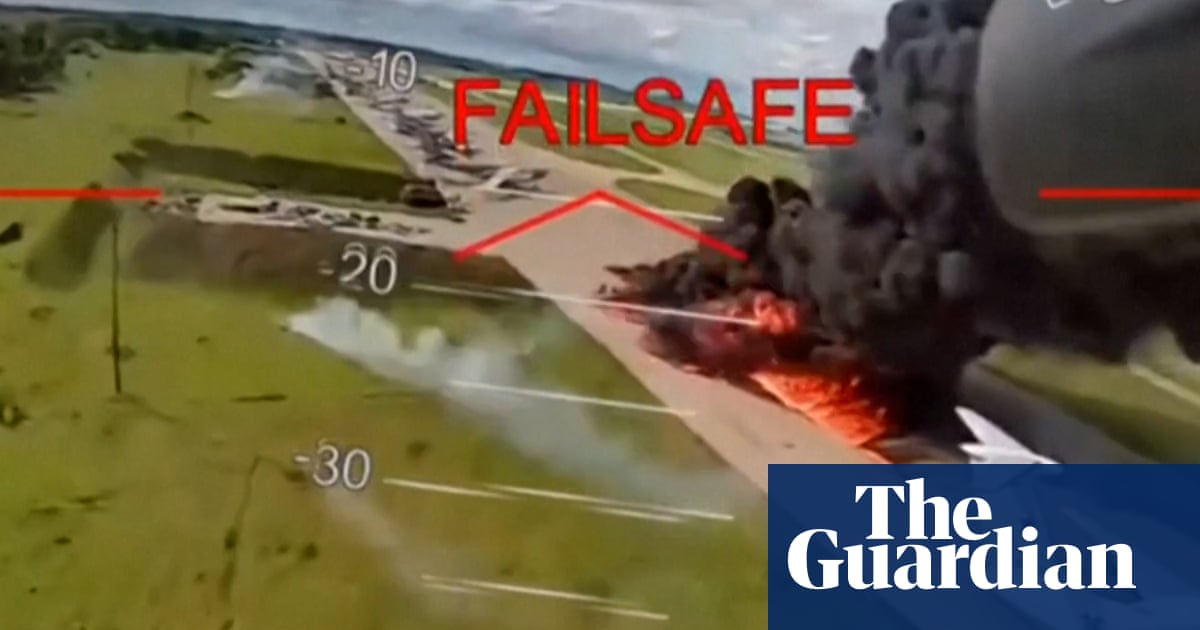AsVladimir Putinpledges to retaliate against Ukraine for last weekend’sunprecedented drone attack, Kremlin advisers and figures aroundDonald Trumphave told the US president that the risk of a nuclear confrontation is growing, in an attempt to pressure him to further reduce US support forUkraine.
Kirill Dmitriev, the head ofRussia’s sovereign wealth fund and an important intermediary between the Kremlin and Trump’s envoy Steve Witkoff, called the Ukrainian drone strike an attack on “Russian nuclear assets”, and echoed remarks from Maga-friendly figures warning of the potential for a third world war.
“Clear communication is urgent – to grasp reality and the rising risks before it’s too late,” Dmitriev wrote, adding a dove emoji.
Ukraine claimed that the strike damaged more than 40 Russian planes, including Tu-95 and Tu-22M heavy bombers that have been used to launch cruise missiles at Ukrainian cities throughout the war, killing thousands and damaging crucial infrastructure that delivers heat and electricity to millions more.
But those planes can also carry weapons armed with nuclear warheads, and are part of a nuclear triad along with submarine and silo-based missiles that form the basis for a system of deterrence betweenRussiaand the United States.
After a phone call between the two leaders on Wednesday, Trump said: “President Putin did say, and very strongly, that he will have to respond to the recent attack on the airfields.”
Ukraine voluntarily gave up its nuclear weapons in 1994, in return for security assurances from the US, the UK and Russia.
Those skeptical of US support for Ukraine are seizing on the risks of a nuclear confrontation to argue that the conflict could possibly spin out of control.
Maga (Make America great again) influencers such asSteve Bannonand Charlie Kirk have openly condemned the drone attack, with Bannon likening the strike to Japan’s attack on Pearl Harbor and Kirk writing: “Most people aren’t paying attention, but we’re closer to nuclear war than we’ve been since this began in 2022.”
But more centrist advisers within the Trump camp – including some who have closer links to Ukraine – are also warning that the risks of a nuclear conflict are growing as they seek to maintain Trump’s interest in brokering a peace.
“The risk levels are going way up,” Keith Kellogg, Trump’s envoy for Ukraine and Russia, told Fox News. “When you attack an opponent’s part of their [nuclear] triad, your risk level goes up because you don’t know what the other side is going to do. And that’s what they did.”
Kellogg also repeated rumours that Ukraine had struck the Russian nuclear fleet at Severomorsk, although reports of an explosion there have not been confirmed. He said the US was “trying to avoid” an escalation.
Other current and former members of the administration skeptical of US support for Ukraine have also vocally opposed the drone strikes.
“It is not in America’s interest for Ukraine to be attacking Russia’s strategic nuclear forces the day before another round of peace talks,” said Dan Caldwell, an influential foreign policy adviser who was a senior aide to Pete Hegseth at the Pentagon until he was purged amid a leaking scandal last month.
“This has the potential to be highly escalatory and raises the risk of direct confrontation between Russia and Nato,” he said. “US should not only distance itself from this attack but end any support that could directly or indirectly enable attacks against Russian strategic nuclear forces.”
It is not the first time that concerns over Russia’s use of a nuclear weapon have been used to try to temper US support for Ukraine.
As Moscow’s forces were routed near Kharkiv and in the south at Kherson in September 2022, Russian officials sent signals that the Kremlin was considering using a battlefield nuclear weapon, senior Biden officials have said.
National security officials said they believed that if the Russian lines collapsed and left open the potential for a Ukrainian attack on Crimea, then there was a 50% chance that Russia would use a nuclear weapon as a result.
Ukrainian officials have responded by saying that Russia has embellished its threats of a nuclear attack in order to blackmail the US from giving greater support to Ukraine.
